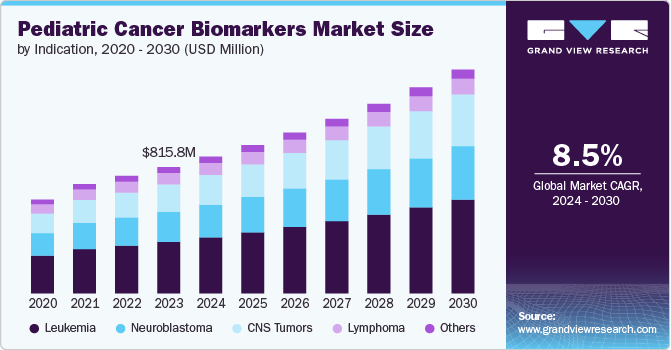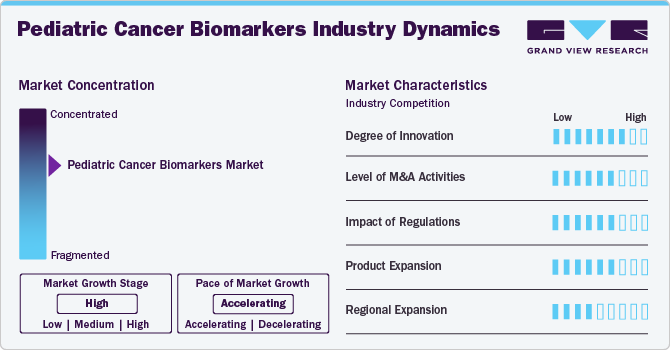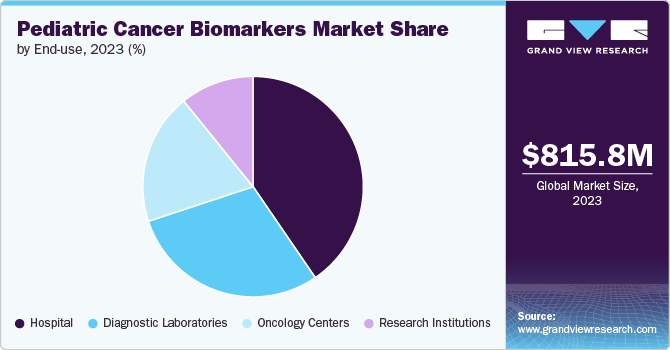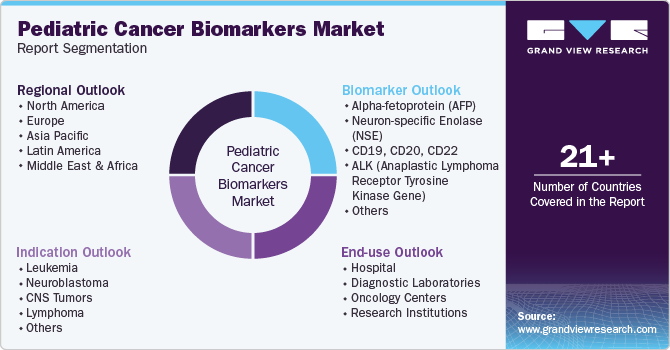
Pediatric Cancer Biomarkers Market Size, Share & Trends Analysis Report By Indication (Leukemia, Neuroblastoma, CNS Tumors, Lymphoma), By Biomarker (Alpha-fetoprotein, Neuron-specific enolase), By End Use, And Segment Forecasts, 2024 - 2030
- Report ID: GVR-4-68040-440-6
- Number of Report Pages: 120
- Format: PDF, Horizon Databook
- Historical Range: 2018 - 2023
- Forecast Period: 2024 - 2030
- Industry: Healthcare
Pediatric Cancer Biomarkers Market Trends
The global pediatric cancer biomarkers market size was estimated at USD 815.81 million in 2023 and is projected to grow at a CAGR of 8.5% from 2024 to 2030, due to the increasing prevalence of pediatric cancers and advancements in molecular biology. According to the National Cancer Institute at the National Institutes of Health, it is projected that in 2024, approximately 9,620 children aged 0 to 14 will be diagnosed with cancer, and an estimated 1,040 will succumb to the disease. As diagnostic tools improve, the demand for biomarkers that can accurately detect and monitor cancer in children has surged. These biomarkers, which include genetic, epigenetic, and protein-based markers, are crucial in enabling early diagnosis, personalized treatment, and better prognosis, driving the market forward. Additionally, growing investments in research and development from both government and private sectors have accelerated the discovery and validation of new biomarkers.

Additionally,Technological advancements play a pivotal role in the growth of the pediatric cancer biomarkers market. Innovations in next-generation sequencing (NGS), bioinformatics, and molecular imaging have revolutionized biomarker discovery and validation processes. These technologies enable the identification of specific biomarkers associated with various pediatric cancers, allowing for more accurate and early diagnosis. NGS, for instance, facilitates the comprehensive analysis of cancer genomes, leading to the discovery of novel genetic mutations that can serve as potential biomarkers.These technological innovations enhance the precision of diagnostics and contribute to the development of targeted therapies, further driving the market growth.
Moreover, research in this field has intensified, with a focus on identifying novel biomarkers that can not only detect cancer at an early stage but also predict treatment response and disease progression. In March 2022, the National Cancer Institute (NCI) introduced the Molecular Characterization Initiative, a program offering tumor molecular characterization, commonly referred to as biomarker testing, to children and adolescents. The initiative primarily targets individuals newly diagnosed with tumors who are undergoing treatment at hospitals. This research is crucial for developing personalized treatment strategies, which are particularly important in pediatric oncology, where minimizing long-term side effects is a priority. Advancements in technologies such as next-generation sequencing (NGS) and liquid biopsies have also accelerated biomarker discovery, enabling more comprehensive and non-invasive testing options.
Investment plays a pivotal role in driving this market. Governments and private companies are increasingly funding pediatric oncology research, recognizing the potential for innovative biomarkers to improve patient outcomes. Significant financial support from organizations like the National Cancer Institute and various biotech firms are facilitating the development and commercialization of new biomarkers, thus ensuring sustained growth in the pediatric cancer biomarkers market.
Market Concentration & Characteristics
The pediatric cancer biomarkers market is marked by a high degree of innovation, driven by advancements in sensor technology, digital integration, and non-contact infrared capabilities. Innovations such as Bluetooth-enabled smart thermometers allow seamless data tracking and analysis via mobile apps, while dual-mode indications offer both ear and forehead measurements. These technological advancements enhance accuracy, convenience, and user experience, significantly boosting market growth and adoption.
The pediatric cancer biomarkers market is witnessing an increasing level of mergers and acquisitions (M&A) activity as companies seek to enhance their portfolios and expand their capabilities. For instance, in February 2021, IARC and St. Jude announced a partnership to expand global pediatric cancer registries. This initiative aims to improve and broaden data collection in low- and middle-income countries, supporting global efforts to enhance childhood cancer survival rates. Larger pharmaceutical and biotechnology firms are acquiring smaller, innovative companies to access cutting-edge biomarker technologies and strengthen their position in the market, driving consolidation and accelerating advancements in pediatric cancer diagnostics and treatments.

Regulations significantly impact the pediatric cancer biomarkers market by ensuring the safety, efficacy, and quality of diagnostic tools. Stringent regulatory standards, particularly from agencies like the FDA and EMA, govern the approval and commercialization of new biomarkers. These regulations promote rigorous testing and validation, ensuring that only clinically proven biomarkers reach the market, thus fostering trust and adoption in pediatric oncology.
Product expansion in the pediatric cancer biomarkers market is accelerating as companies develop and introduce a wider range of biomarkers for various cancer types. Companies are focusing on expanding their product portfolios to include biomarkers for rare and hard-to-diagnose pediatric cancers, enhancing their market presence. This expansion is supported by ongoing research and development efforts, which are crucial in addressing the unmet needs in pediatric oncology.
Regional expansion in the pediatric cancer biomarkers market is driven by growing healthcare infrastructure and increasing awareness in emerging markets like Asia-Pacific and Latin America. These regions are seeing greater access to advanced diagnostic technologies, supported by government initiatives and international collaborations. As a result, companies are expanding their presence, tapping into new markets, and driving global growth in pediatric cancer care.
Indication Insights
The leukemia segment held the largest share of 40.8% in 2023, owing to the high incidence and need for early detection of this cancer type. According to the National Cancer Institute, the incidence rate of childhood leukemia was 4.8 per 100,000 children annually, with a mortality rate of 0.5 per 100,000 children each year. These age-adjusted rates are based on data from 2017-2021 for new cases and 2018-2022 for deaths. The demand for precise biomarkers in diagnosing and monitoring leukemia is growing, as early detection significantly improves treatment outcomes. The segment's expansion is further fueled by advancements in molecular diagnostics and personalized medicine, offering new opportunities for targeted therapies in pediatric leukemia.
The CNS tumors segment is expected to grow at the fastest CAGR of 9.7% over the forecast period, driven by the high prevalence of these tumors among children. According to the American Cancer Society, as of January 2023, brain and spinal cord tumors are the second most common cancers in children, following leukemia, and account for approximately 25% of all childhood cancers. Each year, over 4,000 children and teens are diagnosed with these tumors. The demand for specific biomarkers that can accurately diagnose and monitor CNS tumors is increasing, as early and precise detection is critical for effective treatment. This segment's growth is further bolstered by advancements in molecular diagnostics and personalized medicine, offering new avenues for targeted therapies and improving outcomes for pediatric patients with CNS tumors.
Biomarker Insights
The CD19, CD20, CD22 segments held the largest share of 29.7% in 2023. The CD19, CD20, and CD22 biomarkers are critical in the pediatric cancer biomarkers market, particularly for their role in targeted therapies for B-lineage acute lymphoblastic leukemia (B-ALL). These biomarkers are integral to the success of therapies like CD19-targeted chimeric antigen receptor T-cell (CAR-T) therapy, which has shown exceptional efficacy in treating relapsed or refractory pediatric B-ALL. According to a study published by the National Institutes of Health in March 2023, CAR-T therapy led to minimal residual disease (MRD)-negative complete remission in all five patients treated, with 6- and 12-month overall survival rates at an impressive 100%. The growing demand for therapies targeting these biomarkers is driving market expansion, as their success significantly improves survival rates and offers new hope for pediatric cancer patients.
The ALK (anaplastic lymphoma receptor tyrosine kinase gene) segment is expected to grow at a CAGR Of 10.8% over the forecast period. According to a 2021 ScienceDirect report, ALK is crucial in treating anaplastic large cell lymphoma (ALCL), inflammatory myofibroblastic tumors (IMT), certain neuroblastomas, and CNS tumors. ALK inhibition has shown promise in achieving remission, particularly in relapsed ALCL cases. This has spurred advancements in targeted therapies, driving market expansion in pediatric oncology.
End Use Insights
The hospital segment held the largest share of 40.5% in 2023, driven by increasing investments and government support. Hospitals are adopting advanced biomarker technologies to improve diagnostic accuracy and personalized treatments for pediatric cancers. Government initiatives, such as funding for research and development and incentives for implementing innovative diagnostics, are bolstering market expansion. Additionally, growing investments from private companies in biomarker research and development are enhancing the availability and efficacy of new diagnostic tools. This collaborative effort between the public and private sectors is accelerating the adoption of cutting-edge biomarkers in pediatric oncology, thus propelling market growth.

The research institutions segment is growing at a fastest CAGR of 9.9% driven by escalating research activities and breakthroughs. These institutions play a pivotal role in advancing biomarker discovery and validation, fostering innovation in cancer diagnostics and treatments. Increased funding and grants from government bodies and private organizations are fueling extensive research into biomarkers specific to pediatric cancers. This focus on identifying novel biomarkers and understanding their mechanisms is leading to the development of more targeted and effective therapies. As research institutions continue to make significant strides, their contributions are crucial to the growth and advancement of the pediatric cancer biomarkers market.
Regional Insights
North America pediatric cancer biomarkers market dominated the overall global market and accounted for the 43.8% -revenue share in 2023, driven by increasing research and development efforts. In September 2020, Johns Hopkins researchers identified a new diagnostic marker that differentiates a fast-growing form of medulloblastoma, a pediatric brain cancer, from a less aggressive type. Such discoveries are propelling advancements in personalized medicine, improving diagnostic precision, and fueling market expansion in the region.
U.S. Pediatric Cancer Biomarkers Market Trends
Pediatric cancer biomarkers market in the U.S. held a significant share of North America market in 2023, driven by strong government support, significant investments, and funding initiatives. The Childhood Cancer Data Initiative (CCDI), announced in the 2019 President's State of the Union address, represents a substantial federal investment of USD 50 million annually over ten years. This initiative aims to advance pediatric cancer research by generating new data and developing platforms for data sharing, driving market growth.
Europe Pediatric Cancer Biomarkers Market Trends
Pediatric cancer biomarkers market in Europe is experiencing significant growth, fueled by technological advancements and intensive research efforts in pediatric oncology. Cutting-edge technologies, such as next-generation sequencing and proteomics, are enhancing biomarker discovery and diagnostic precision. European research institutions are increasingly focused on identifying novel biomarkers for pediatric cancers, driving innovation in personalized medicine. This synergy between technological progress and dedicated research is propelling the market's expansion across the region.
The UK pediatric cancer biomarkers market is experiencing significant growthas research intensifies to address the unique cancer types affecting children. According to Cancer Research UK, approximately 1,838 children (aged 0-14) are diagnosed with cancer annually, including benign brain tumors. The distinct nature of pediatric cancers drives the need for specialized biomarkers, enhancing diagnostic accuracy and treatment approaches in the UK market.
Pediatric cancer biomarkers market in Germany is experiencing significant growth, driven by advancing technology and increasing research efforts. The Deutsches Krebsforschungszentrum (German Cancer Research Center) has established the Junior Research Group Digital Biomarkers for Oncology, focusing on developing robust and interpretable digital biomarkers. This initiative aims to enhance prevention, non-invasive early detection, diagnosis, and treatment of pediatric cancers. Such advancements are fueling innovation and driving the market's expansion in Germany.
Asia Pacific Pediatric Cancer Biomarkers Market Trends
Pediatric cancer biomarkers market in Asia Pacificis experiencing the fastest growth,due to the increasing incidence of childhood cancers in countries like China and India. In India, the 2020 National Cancer Registry Programme (NCRP) report indicates that cancers in children aged 0-14 represent 4.0% of all cancer cases. The Population Based Cancer Registry in Delhi highlights the region’s significant rates, with the highest age-adjusted incidence rate (AAR) of 203.1 per million in boys and 125.4 per million in girls. Enhanced healthcare infrastructure and investment in advanced diagnostics are further driving market growth in this dynamic region.
The China pediatric cancer biomarkers market is growing, driven by high cancer prevalence among children. According to The Lancet report published in January 2023, approximately 121,145 cancer cases were diagnosed in children and adolescents in China from 2018 to 2020. The study also found a positive correlation between oncology incidence and regional socioeconomic status, highlighting the need for improved diagnostic tools and treatments.
Pediatric cancer biomarkers market in Japan is experiencing growth due to advancing research and technology. Enhanced research efforts and cutting-edge technologies, such as genomic sequencing and biomarker profiling, are driving innovations in diagnostic and therapeutic approaches for cancer. This progress is significantly contributing to market expansion and improved treatment outcomes in Japan.
Latin America Pediatric Cancer Biomarkers Market Trends
The Latin America pediatric cancer biomarkers marketis experiencing significant growth,by improving healthcare infrastructure and increasing awareness of oncology diagnoses in children. Enhanced medical facilities and greater emphasis on early detection are driving advancements in diagnostic technologies and contributing to market growth in the region.
Middel East and Africa Pediatric Cancer Biomarkers Market Trends
Pediatric cancer biomarkers market in MEAis expanding due to increased funding in healthcare and advancements in oncology research. Enhanced financial support for healthcare infrastructure and research initiatives is facilitating the development of innovative diagnostic tools and improving early detection capabilities for pediatric tumor, driving market expansion across the Middle East and Africa.
Key Pediatric Cancer Biomarkers Company Insights
The competitive scenario in the pediatric cancer biomarkers market is high, with key players such as Baxter (Hillrom Holdings Inc.); Cardinal Health; 3M; McKesson Corporation; Mediaid, Inc.; Innovo Medical; Microlife Corporation; American Diagnostic Corporation holding significant positions. The major companies are undertaking various strategies such as new product development, collaborations, acquisitions, mergers, and regional expansion for serving the unmet needs of their customers.
Key Pediatric Cancer Biomarkers Companies:
The following are the leading companies in the pediatric cancer biomarkers market. These companies collectively hold the largest market share and dictate industry trends.
- F. Hoffmann-La Roche Ltd
- Abbott
- Siemens Healthineers
- Thermo Fisher Scientific
- QIAGEN
- Myriad Genetics
- Beckman Coulter
- Bio-Rad Laboratories
- Agilent Technologies
- BIOMÉRIEUX
- RayBiotech, Inc
- Randox Laboratories Ltd.
Recent Developments
-
In June 2024, Sapience Therapeutics, Inc., a clinical-stage biotechnology firm specializing in peptide therapeutics for oncogenic and immune dysregulation, showcased new clinical and biomarker data from its Phase 2 ST101 study.
-
In June 2024, the Cancer Research UK National Biomarker Centre was inaugurated. This cutting-edge facility was established through a combination of fundraising, philanthropic contributions, and collaboration among Cancer Research UK, the University of Manchester, and the Christie NHS.
-
In March 2024, UCSF researchers identified a new pediatric cancer marker, offering new hope for treatment targets. They discovered a critical vulnerability in neuroblastoma, a cancer that represents 15% of all pediatric cancer deaths.
Pediatric Cancer Biomarkers Market Report Scope
|
Report Attribute |
Details |
|
Market size value in 2024 |
USD 884.06 million |
|
Revenue forecast in 2030 |
USD 1,445.64 million |
|
Growth rate |
CAGR of 8.5% from 2024 to 2030 |
|
Historical data |
2018 - 2023 |
|
Forecast period |
2024 - 2030 |
|
Quantitative units |
Revenue in USD million and CAGR from 2024 to 2030 |
|
Report coverage |
Revenue forecast, company ranking, competitive landscape, growth factors, and trends |
|
Segments covered |
Indication, biomarker, end use |
|
Regional scope |
North America; Europe; Asia Pacific; Latin America; and MEA |
|
Country scope |
U.S.; Canada; Mexico UK; Germany; France; Italy; Spain; Norway; Denmark; Sweden; China; Japan; India; Australia; Thailand; South Korea; Brazil; Argentina; South Africa; Saudi Arabia; UAE; Kuwait |
|
Key companies profiled |
F. Hoffmann-La Roche Ltd; Abbott; Siemens Healthineers; Thermo Fisher Scientific; QIAGEN; Myriad Genetics; Beckman Coulter; Bio-Rad Laboratories; Agilent Technologies; BIOMÉRIEUX; RayBiotech, Inc; Randox Laboratories Ltd. |
|
Customization scope |
Free report customization (equivalent up to 8 analyst working days) with purchase. Addition or alteration to country, regional & segment scope. |
|
Pricing and purchase options |
Avail customized purchase options to meet your exact research needs. Explore purchase options |
Global Pediatric Cancer Biomarkers Market Report Segmentation
This report forecasts revenue growth at country levels and provides an analysis on the latest industry trends and opportunities in each of the sub-segments from 2018 to 2030. For this study, Grand View Research has segmented the pediatric cancer biomarkers market report based on indication, biomarker, end use and region.

-
Indication Outlook (Revenue, USD Million, 2018 - 2030)
-
Leukemia
-
Neuroblastoma
-
CNS Tumors
-
Lymphoma
-
Others
-
-
Biomarker Outlook (Revenue, USD Million, 2018 - 2030)
-
Alpha-fetoprotein (AFP)
-
Neuron-specific enolase (NSE)
-
CD19, CD20, CD22
-
ALK (anaplastic lymphoma receptor tyrosine kinase gene)
-
Others
-
-
End Use Outlook (Revenue, USD Million, 2018 - 2030)
-
Hospital
-
Diagnostic Laboratories
-
Oncology Centers
-
Research Institutions
-
-
Regional Outlook (Revenue, USD Million, 2018 - 2030)
-
North America
-
U.S.
-
Canada
-
Mexico
-
-
Europe
-
UK
-
Germany
-
France
-
Italy
-
Spain
-
Norway
-
Denmark
-
Sweden
-
-
Asia Pacific
-
Japan
-
China
-
India
-
Australia
-
South Korea
-
Thailand
-
-
Latin America
-
Brazil
-
Argentina
-
-
Middle East & Africa
-
South Africa
-
Saudi Arabia
-
UAE
-
Kuwait
-
-
Frequently Asked Questions About This Report
b. The global pediatric cancer biomarkers market size was estimated at USD 815.81 million in 2023 and is expected to reach USD 884.06 million in 2024.
b. The global pediatric cancer biomarkers market is expected to grow at a compound annual growth rate of 8.54% from 2024 to 2030 to reach USD 1,445.64 million by 2030.
b. North America dominated the pediatric cancer biomarkers market with a share of 43.84% in 2023. This is attributable to the rising number of cancer cases in pediatric population
b. Some key players operating in the pediatric cancer biomarkers market include Key companies profiled F. Hoffmann-La Roche Ltd; Abbott; Siemens Healthineers; Thermo Fisher Scientific; QIAGEN; Myriad Genetics; Beckman Coulter; Bio-Rad Laboratories; Agilent Technologies; BIOMÉRIEUX; RayBiotech, Inc; Randox Laboratories Ltd.
b. Key factors that are driving the market growth include the rising incidence of pediatric cancer and advancements in genomics and proteomics
We are committed towards customer satisfaction, and quality service.
"The quality of research they have done for us has been excellent."




